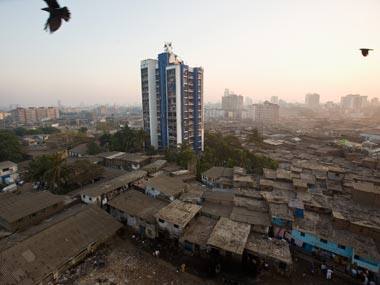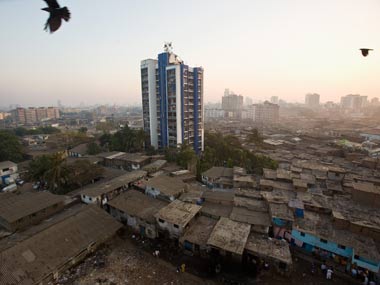In a city where Antilia, a 27-story, single-family residence, the Malabar Hills, Juhu bungalows, and the slums on Reay Road sidewalks so tiny that multiple families use a common kitchen to save on scarce space, co-exist, it is hard to know who the common man is. Mumbai’s Rs 1,51,608 per capita income for 2011-12 is certainly no mean or median.
Somewhere in there lurks this undefinable common man. In the context of housing, where the sheer unaffordability as well as unavailability of adequate stock keeps Mumbai in a different category of cities, he could be just about anybody. It is a destination for employment, any kind of employment, but certainly not a destination of choice hyphenated to housing.
It is for this ‘ordinary man’, a term often used by Maharashtra politicians and bureaucrats, and notably, not the builder-developers, is the State supposed to be helping ease the acute shortage of housing.
Everything has been thrown up in the air as a way to resolve the housing crisis - hikes in the floor space index (FSI), allowing transfer of development rights (TDR), redevelopment of old buildings either singly or in clusters, rental housing replacement housing for the slum dwellers - yet nothing seems to have worked.
[caption id=“attachment_770521” align=“alignleft” width=“380”] In Slum Rehabilitation Authority’s slum conversions to planned habitats with improved housing, an idea born in in 1996, only 1.53 lakh slum dwellers have been given replacement housing.[/caption]
In Slum Rehabilitation Authority’s slum conversions to planned habitats with improved housing, an idea born in in 1996, only 1.53 lakh slum dwellers have been given replacement housing.[/caption]
Profits, and where possible, profiteering, drives the private sector real estate operators, big and small, organised and corporate. On the other hand, efforts in the public sector have been sorely lacking in the desired push. Public housing, despite the high per capita incomes, has failed Mumbai.
If one goes by the claims of the ‘official speak’ on the issue of public housing, it would seem that all is taken care of, except, of course, their execution and realised goals. Maharashtra Housing and Area Development Authority (Mhada), for instance, is now flapping about unable to deliver the houses planned within the timelines announced. It’s also unable to deliver at prices at which the apartments were allotted to those eligible by winning the annual lotteries.
Two examples should suffice to illustrate the contention. First, last year, after the houses were allotted, post the lottery for which there are between 100-150 hopefuls for each apartment, the prices were jacked up by a hefty 40 percent in a supplementary bill. This year, of the 1,259 apartments, only 251 have been built.
Not all flats built in 2010 and 2011 across Mumbai, though allotted and bought, could be occupied in the absence of occupation certificates (OC). In the absence of such OCs, living in them, despite the deal done and delivered, is illegal. Buyers have started paying their EMI payments on the mortgages.
In a city where slums are easier formed than a formal house built, Mhada has been a poor performer. In the eight years since 2008, a tad less than 15,000 flats have been built and sold. The number of people who bid their luck by enrolling for a lottery were a little over an astounding one million potential buyers. That tells you of the demand and the supply.
The idea of half a million rental flats, to be built in far-off suburbs like Kalyan are more or less on ice. It prefers enlarging their sizes and selling instead, though the initial target clientele was the slum dwellers. This was the project of the MMRDA, of which there is no progress report.
That the slum dwellers are a huge group requiring even passable housing in comparison to the hovels they live in, has never been in dispute. The 2011 census had put over 44 percent of all households in Mumbai in the category of slum dwellings. The 2001 Census had put 54.6 percent of Mumbai population in the same category.
Among them, only those who have been residents in dwellings built prior to 1995 are entitled for resettlement projects and others are hopeful of getting into that bracket sooner or later. The government has said it was committed to a new cut-off of 2000 but the Supreme Court is yet to clear it. Importance of slums as vote banks keeps such hopes alive.
In Slum Rehabilitation Authority’s slum conversions to planned habitats with improved housing, an idea born in in 1996, only 1.53 lakh slum dwellers have been given replacement housing. Of the 2,395 cleared projects, only 597 have been done. Builders are squatting on slum lands after accords with the slum dwellers. They are trying to figure out the lag.
While the MMRDA toys around with ‘rent, no, sell’ ideas, the Mhada is now forced to concede its pace of construction has lagged. It has said it hiked prices because it miscalculated it for working out costs.
So dire has this development with Mhada become that a peeved Housing Minister, Sachin Ahir, wrote complaining of this trend to the chief minister. Deputy Chief Minister, Ajit Pawar also grumbled about the “unreasonable” prices but the Chief Minister, Prithviraj Chavan, has refused to order a price cut as the Mhada prices are cheaper than the private builder buildings.
Indian Express had reported how buyers of Mhada apartments, old or new price, find them in “shambles” when buyers move in. Broker fixtures, improper plastering, leakages are what greeted a family. Their moving-in cost now would go up by Rs 1 lakh. Once you have sunk all you have, every another Rs 1,000 is that much tougher to be raised.
Even the Dharavi project has had excruciating delays. No doubt there are pros and cons of the scheme to the slum dwellers as well as the city, but it has not caught any steam yet. An appropriate balance between the slum dwellers concerns and the builder-developers’ has not yet been worked out and one has to believe the first sector assigned to Mhada will work out.
No one knows yet by when though the project’s chief had recently told a Marathi newspaper, Pudhari that, if everything were in place - consents, plans, approvals, funding etc. - then the entire Dharavi area could be redeveloped in five years. But more time than that has passed since the Dharavi redevelopment was thought of and yet, the city is groping for solutions to the housing crisis.
Mahesh Vijapurkar likes to take a worm’s eye-view of issues – that is, from the common man’s perspective. He was a journalist with The Indian Express and then The Hindu and now potters around with human development and urban issues.
)